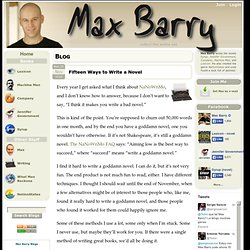

3 Steps to Writing a Novel with Unforgettable Characters. Character development is one of the first essential steps of writing a novel and it involves creating the people who will carry out your story.

There will most likely be a variety of characters needed for your story, but none as important as your lead character – your protagonist. A well-developed protagonist has much to do with the success of writing a novel. When writing a novel, the protagonist should be someone that your readers feel is a “real person” that they come to love (or at least like a whole lot), can relate to in many ways, and will care about and think about long after they’ve turned the final page on your novel. Seven Tips From Ernest Hemingway on How to Write Fiction. Image by Lloyd Arnold via Wikimedia Commons Before he was a big game hunter, before he was a deep-sea fisherman, Ernest Hemingway was a craftsman who would rise very early in the morning and write.

His best stories are masterpieces of the modern era, and his prose style is one of the most influential of the 20th century. Hemingway never wrote a treatise on the art of writing fiction. He did, however, leave behind a great many passages in letters, articles and books with opinions and advice on writing. Some of the best of those were assembled in 1984 by Larry W. 1: To get started, write one true sentence. Hemingway had a simple trick for overcoming writer's block. Sometimes when I was starting a new story and I could not get it going, I would sit in front of the fire and squeeze the peel of the little oranges into the edge of the flame and watch the sputter of blue that they made. 2: Always stop for the day while you still know what will happen next. 5: Don't describe an emotion--make it.
Fifteen Ways to Write a Novel. Every year I get asked what I think about NaNoWriMo, and I don’t know how to answer, because I don’t want to say, “I think it makes you write a bad novel.”

This is kind of the point. You’re supposed to churn out 50,000 words in one month, and by the end you have a goddamn novel, one you wouldn’t have otherwise. If it’s not Shakespeare, it’s still a goddamn novel. The NaNoWriMo FAQ says: “Aiming low is the best way to succeed,” where “succeed” means “write a goddamn novel.” I find it hard to write a goddamn novel. Some of these methods I use a lot, some only when I’m stuck. The Word TargetWhat: You don’t let yourself leave the keyboard each day until you’ve hit 2,000 words. How to Write a Novel Using the Snowflake Method. Writer's Café fiction writing software - novels - screenwriting - short stories - creative fun. Your Novel Blueprint. A Simple Novel Outline – 9 questions for 25 chapters « H.E. Roulo. Just as every tree is different but still recognizably a tree, every story is different but contains elements that make it a story.

By defining those before you begin you clarify the scope of your work, identify your themes, and create the story you meant to write. At Norwescon 2011 I sat in on a session called Outline Your Novel in 90-minutes led by Mark Teppo. I’ll give you the brief, readable, synthesized version. Answer 9 questions and create 25 chapter titles and you’re there. Here are the 9 questions to create a novel: 1.) 2.) 3.) 4.) 5.) 6.) 7.) 8.) 9.) Now, with those 9 questions answered to your satisfaction, try to fill in a 25 chapter, 75,000 word outline. Chapters 7-18 are the middle of your book. Chapters 19-25 depict the heroic act to victory. Wasn’t that easy?
Okay, sure, the work isn’t done yet. Using the idea that there are 25 chapters, I outlined my current work in progress. How To Make Sure You Finish The First Draft Of Your Novel - Write Publish Now. Manuscript Format for Novels. By Glen C.

Strathy The manuscript format used in publishing has evolved a little over time as technology has changed, and if you grew up with word processors, it may seem rather quaint, old-fashioned, and downright boring to look at. Word processors come with many desktop publishing capabilities that are so tempting to use. And if you were working in any other business, you would probably take advantage of them to give your document a distinctive and attractive look. However, if you are submitting your book to agents and/or publishers, it is best to forget about all that and follow the correct manuscript format for publishing that was developed back in the days before word processors existed and professional writers used typewriters. There are several reasons why this format became standard. 1. Think about this. 2. Despite the fact that everyone uses computers, many editors still like to look at a hard copy and make editing marks in pencil between lines and in margins.